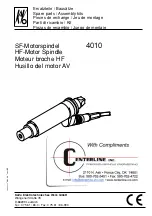
English
8
READ ALL INSTRUCTIONS
Important Safety Instructions for All
Battery Packs
WARNING:
Read all safety warnings, instructions,
and cautionary markings for the battery pack,
charger and product. Failure to follow the
warnings and instructions may result in electric
shock, fire and/or serious injury.
•
Do not charge or use the battery pack in explosive
atmospheres, such as in the presence of flammable
liquids, gases or dust.
Inserting or removing the battery
pack from the charger may ignite the dust or fumes.
•
NEVER force the battery pack into the charger. DO
NOT modify the battery pack in any way to fit into a
non‑compatible charger as battery pack may rupture
causing serious personal injury.
Consult the chart
at the end of this manual for compatibility of batteries
and chargers.
•
Charge the battery packs only in
CRAFTSMAN chargers.
•
DO NOT
splash or immerse in water or other liquids.
•
DO NOT
allow water or any liquid to enter battery pack.
•
Do not store or use the tool and battery pack in
locations where the temperature may reach or
exceed 104 °F (40 °C) (such as outside sheds or metal
buildings in summer).
For best life store battery packs in
a cool, dry location.
NOTE: Do not store the battery packs in a tool with
the trigger switch locked on. Never tape the trigger
switch in the ON position.
•
Do not incinerate the battery pack even if it is severely
damaged or is completely worn out.
The battery pack
can explode in a fire. Toxic fumes and materials are created
when lithium‑ion battery packs are burned.
•
Do not expose a battery pack or appliance to fire or
excessive temperature.
Exposure to fire or temperature
above 265 °F (130 °C) may cause explosion.
•
Follow all charging instructions and do not charge
the battery pack or appliance outside of the
temperature range specified in the instructions.
Charging improperly or at temperatures outside of the
specified range may damage the battery and increase the
risk of fire.
BATTERIES AND CHARGERS
The battery pack is not fully charged out of the carton.
Before using the battery pack and charger, read the
safety instructions below and then follow charging
procedures outlined. When ordering replacement battery
packs, be sure to include the catalog number and voltage.
..................... visible radiation
do not stare into
the light
..................... wear respiratory
protection
..................... wear eye protection
..................... wear hearing
protection
..................... read all
documentation
The label on your tool may include the following symbols. The
symbols and their definitions are as follows:
V ......................... volts
Hz .......................hertz
min .....................minutes
or DC ......direct current
...................... Class I Construction
(grounded)
…/min ..............per minute
BPM ....................beats per minute
IPM .....................impacts per minute
OPM .................... oscillations per
minute
RPM .................... revolutions per
minute
sfpm ................... surface feet per
minute
SPM ....................strokes per minute
A .........................amperes
W ........................watts
Wh ......................watt hours
Ah .......................amp hours
or AC ...........alternating current
or AC/DC .... alternating or direct
current
...................... Class II Construction
(double insulated)
no .......................no load speed
n .........................rated speed
PSI....................... pounds per square
inch
......................earthing terminal
.....................safety alert symbol
• ANSI S12.6 (S3.19) hearing protection,
• NIOSH/OSHA/MSHA respiratory protection.
WARNING:
Some dust created by power sanding,
sawing, grinding, drilling, and other construction activities
contains chemicals known to the State of California to
cause cancer, birth defects or other reproductive harm.
Some examples of these chemicals are:
• lead from lead‑based paints,
• crystalline silica from bricks and cement and other
masonry products, and
• arsenic and chromium from
chemically‑treated lumber.
Your risk from these exposures varies, depending on
how often you do this type of work. To reduce your
exposure to these chemicals: work in a well ventilated
area, and work with approved safety equipment, such
as those dust masks that are specially designed to filter
out microscopic particles.
•
Wear protective clothing and wash exposed areas
with soap and water.
Allowing dust to get into your
mouth, eyes, or lay on the skin may promote absorption of
harmful chemicals. Direct particles away from face and body.
•
Use the appropriate dust extractor vacuum to remove
the vast majority of static and airborne dust
. Failure
to remove static and airborne dust could contaminate the
working environment or pose an increased health risk to
the operator and those in close proximity.
•
Use clamps or other practical ways to secure and
support the workpiece to a stable platform.
Holding
the work by hand or against your body is unstable and may
lead to loss of control and injury.
•
Air vents often cover moving parts and should be
avoided.
Loose clothes, jewelry or long hair can be caught
in moving parts.
CAUTION: When not in use, place tool on its
side on a stable surface where it will not cause
a tripping or falling hazard.
Some tools with large
battery packs will stand upright on the battery pack
but may be easily knocked over.
Summary of Contents for CMCE030
Page 5: ...3 Fig G 8 Fig H 8 17 18 ...
Page 43: ......











































